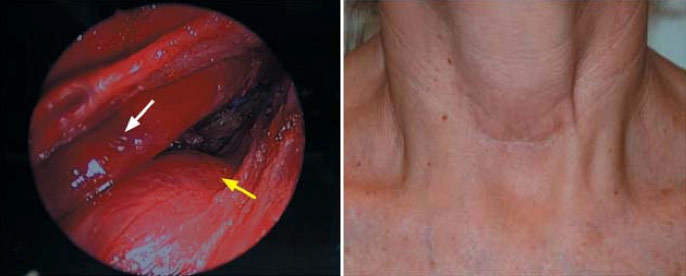- India Medical Mission 2018 - November 1, 2018
- Sleep Disorders: Sleep Apnea and Upper Stimulation Therapy - August 25, 2015
- The Naked Vocalist Podcast Featuring Dr. Reena Gupta - May 27, 2015
- New Therapy for Sleep Apnea – First Sleep Pacemaker placed in California at Osborne Head and Neck Institute. - December 12, 2014
- Boxer’s Ear: Can your ear explode? - December 12, 2014
- Nose Picking (Rhinotillexis) and Septal Perforations: Why I should stop picking my nose…? - November 24, 2014
- Deviated Septum and Septal Perforation - July 28, 2014
- Hereditary Hemorrhagic Telangiectasia: Nasal Septal Perforation Repair - June 25, 2014
- Dr. Mantle recognized at the Beverly Hills Medical Science Academy Awards - May 8, 2014
- Commonly Misdiagnosed Pathologies: Arteriovenous Malformations - April 9, 2014
Can unsightly thyroidectomy scars be avoided?
Question: Over the past year I have developed symptoms of sweating, palpitations, high blood pressure and anxiety that my physician has said are due to an overactive thyroid gland. Recently, I have begun to develop a sensation of fullness in my throat, sometimes making it difficult to breathe. My doctor has stated that a large thyroid nodule has developed and is compressing my “larynx” or windpipe. He has recommended surgical removal of my thyroid because of some concerning biopsy results but warns me that this procedure will leave a large scar across the front of my neck. Is there any way to avoid an unsightly surgical scar from my thyroid surgery?
Discussion:
A thyroidectomy procedure usually requires an incision in the lower part of the neck but large unwanted scars can be minimized by taking appropriate preventative measures. There are several factors that contribute to excellent wound healing after thyroid surgery, including the following:
- Surgical technique;
- Length of incision;
- Wound closure technique;
- Aftercare of incision site; and
- Proper followup.

An atraumatic surgical procedure is a crucial component in wound healing. Cutting edge minimally invasive surgery leads to better recovery for the patient and maximizes wound healing. An experienced surgeon recognizes the importance of minimizing incision size, depth, and trauma to the underlying tissues. Endoscopic thyroid surgery is the new gold standard in minimizing scarring as well as safeguarding laryngeal nerves to prevent vocal paralysis.

Precise closure of the incision site can mean the difference between a virtually undetectable procedure and a noticeable scar. All too often, closure of an incision site is delegated to part of the surgical team as an afterthought. Meticulous suturing as well as close followup can help avoid the appearance of scars.
Dr. Ryan Osborne, Director of Head and Neck Surgery and Dr. Jason Hamilton, Director of Plastic and Reconstructive Surgery, perform endoscopic thyroidectomy at the Osborne Head and Neck Institute (OHNI) in Los Angeles California. Their two-surgeon approach and combined sub specialties allow them to utilize minimally invasive and cutting edge endoscopic techniques to remove the thyroid gland. Dr. Osborne and Hamilton’s approach utilizes an incision size that is a fraction of that seen in traditional surgery, allowing them to visualize the necks underlying structures using a small endoscope without disturbing any critical structures. Dr. Hamilton’s expertise in plastic and reconstructive surgery allows him to close individual tissue layers as well as utilize buried or invisible sutures for the visible top layer of the skin. Furthermore, followup and removal of sutures is also handled exclusively by Dr. Hamilton thus minimizing the appearance of any scars during healing.
Key Points:
- A thyroidectomy procedure usually requires an incision to the front part of the neck but large unwanted scars can be minimized by taking appropriate preventative measures.
- Meticulous surgical technique is a crucial component of excellent wound healing
- Proper closure of an incision site can mean the difference between a virtually undetectable incision site and a noticeable scar.
- Dr. Ryan Osborne, Director of Head and Neck Surgery and Dr. Jason Hamilton, Director of Plastic and Reconstructive Surgery at the Osborne Head and Neck Institute perform endoscopic minimally invasive thyroidectomy that allows for faster recovery.
- Dr. Hamilton’s advanced knowledge of wound healing and postoperative wound care program allows for the best cosmetic outcome.
For more information on minimally invasive thyroidectomy procedures please contact the Osborne Head and Neck Institute.



